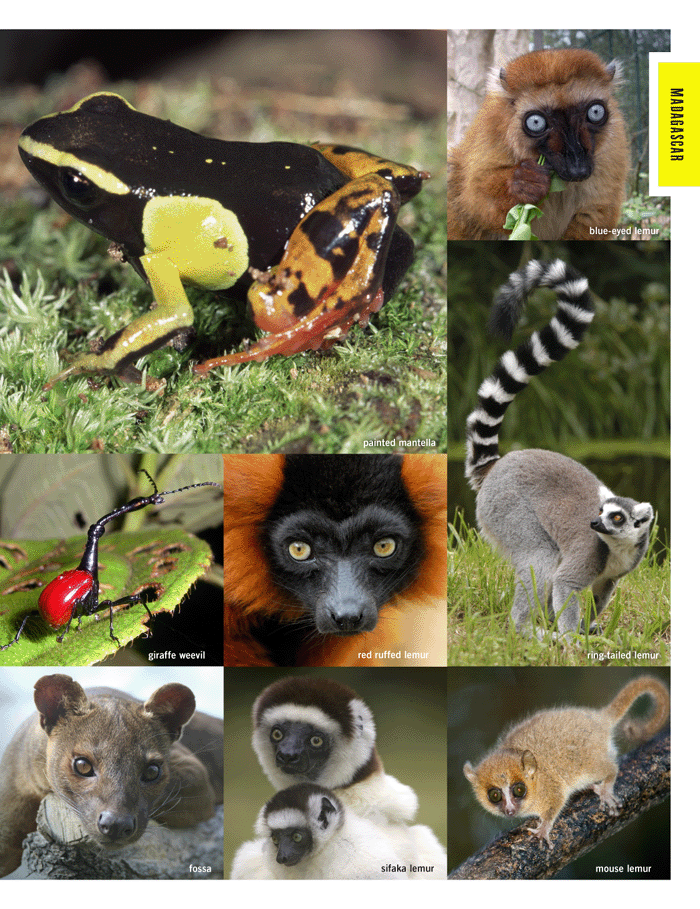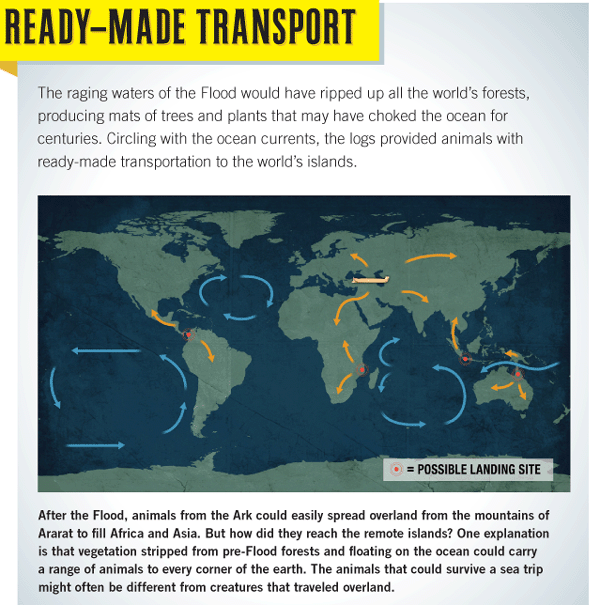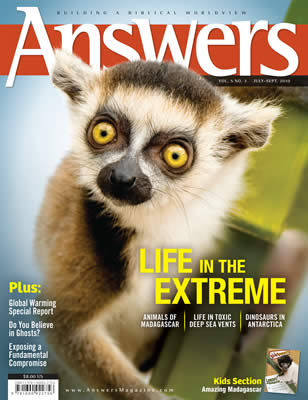Mysterious Madagascar
Extreme Diversity
Some remote islands still conceal fabulous hordes of treasure just waiting to be discovered and enjoyed. Madagascar, off Africa’s east coast, is one of those marvelous places. At least 75% of the species living there are found nowhere else on earth. How’d they get there?
The English sailor Robert Drury is famous for his shipwreck on the island of Madagascar in the 1700s. We know nothing about him except the scant words in his journal.
His mysterious tale1 perfectly fits the mysterious land he crashed into. Sometimes called “the eighth continent,” this island—about the size of France—enthralls us with its unique wildlife, its vivid colors and diverse landscapes, and its hints of past geologic upheaval and radical species diversification. As tantalizing as these marvels are, however, much about Madagascar’s history eludes us, as if the details melt away when we look closely.
The amazing animals that live there—or once did—hold secrets that may help unlock mysteries about how the creatures that left Noah’s Ark quickly resettled the earth after the Flood.
A Puzzle Piece
The history—and mystery—of this large island begins with the land itself. During the year-long Flood (Genesis 6–8), rapid plate movements apparently caused the continents to split, shift position, collide and rejoin briefly, then split again. Madagascar appears to have been torn away from the African coast as a tagalong with India before freeing itself completely. (India raced away and slammed into Asia to create the Himalayas.)
Drifting alone, the island emerged from the Flood waters as a barren landscape waiting to be repopulated. The life that did arrive presents interesting questions for creation researchers.
After the Flood
It appears that Madagascar’s birth began with a blank slate of plains, mountains, and mud. Mats of trees and plants, ripped up from pre-Flood forests, probably choked the ocean and littered the shores. While no animals yet walked on the land, the receding waters had trapped aquatic life in the lakes, rivers, and ponds of the island.
We assume that in just a few decades, the island became host to many varied biomes, from rainforests to thorn forests and desert scrublands.
The reminders of God’s devastating judgment lay buried—and mostly forgotten—in the layers of fresh sediment underfoot. In the northwest Mahajanga basin, a nearly complete skeleton of a titanosaur—a sauropod dinosaur that grew to be nearly 50 feet (15 m) long—would lie undiscovered for another four thousand years. The mud and rock also hid the fossils of a “pug-nosed,” vegetarian crocodile called Simosuchus. Neither of these—nor any of the other pre-Flood remains—have any relation to the animals that arrived later.
Grass and trees, which likely grew from seeds carried in the ocean, sprouted and quickly produced lush vegetation. We assume that in just a few decades, the island became host to many varied biomes, from rainforests to thorn forests and desert scrublands. Insects and other creeping things flew in or blew in from Africa and quickly took to their new home, including a saucer-sized spider that spins webs measuring 3 feet (1 m) across.
The young island was now ripe for larger animals to arrive in these early decades after the Flood, well before the full impact of the Ice Age around the earth.
Explosion of Life
Perhaps driven by the search for food or by curiosity, some intrepid species could have wandered onto floating tree mats and sailed to Madagascar, helped along by ocean currents. Several waves of animals made the trek, each finding niches not filled by the previous castaways. Here, unlike mainland Africa, predators were few and food sources abundant.
Based on genetic data and their amazing diversity, it is likely that lemurs arrived soon after the Flood.2 Although we can’t be exactly sure what these first primate travelers looked like, clues exist. For example, the alleged “missing link” Ida (Darwinius) might have belonged to a lemur/loris kind that lived soon after the Flood. While Ida and most other members of the kind died out on the continents, lemurs found Madagascar a fertile ground.
Once there, the lemurs’ variability became apparent as they reproduced rapidly and moved from the drier western side of the island to the humid east and the mountainous central regions.3 Much like the dog kind, with its amazing array of sizes and behaviors, post-Flood lemurs specialized according to the environment.
Based on the millions of post-Flood species found around the globe, both living and extinct, it appears that the few representatives of animal “kinds” that survived on Noah’s Ark must have diversified rapidly after the Flood—more rapidly, in fact, than we see happening today. One explanation for this amazing process, called mediated design, is described in “Creation’s Hidden Potential” (Answers, January–March 2009).4 God created each separate kind with genes that allowed creatures to adapt to new surroundings while still displaying the basic attributes of the original kind.
Lemurs offer an excellent example of the variety that mediated design produced. From the oddly named aye-aye, a nocturnal lemur with rodent-like teeth and a long finger used to pluck grubs out of holes; to the mouse lemur, which measures only 10.5 inches (27 cm); to the now-extinct koala lemur, which reached 5 feet (1.5 m) in length, the variety within the kind is astounding. The animals, in fact, took on similar roles to what other types of creatures do elsewhere (e.g., the aye-aye finds food much like a woodpecker), which may explain why they failed to become established in other parts of the world.
Another type of animal drifted across the sea—something that, at first glance, might be mistaken for a rodent or marsupial. The versatile tenrec, however, is neither.
This insect-eating mammal also proved capable of rapidly radiating throughout the island. From the original tenrec, colonists became tree dwellers, ground dwellers, and semi-aquatics, with a wide range in the number and arrangement of teeth, fur, sharp spines, complex social systems, head crests, and perhaps even the ability for echolocation using tongue clicks to find prey.
But the interesting puzzles of Madagascar run deeper than just speciation. The more we look, the more questions pile up.

LIKE NO OTHER PLACE ON EARTH
At least 75% of the species living in Madagascar exist nowhere else. For example, if you come across a frog on the island, you have a 99% chance of seeing something unique (such as the painted mantella frog).
But it’s not just frogs. The list of unique species includes insects such as the giraffe weevil, mammals such as the ferocious fossa, and of course, lemurs . . . over seventy lemur species discovered so far.
painted mantella: Barry Mansell | npl | Minden Pictures; blue-eyed lemur: © Loïc ETIENNE; giraffe weevil: http://creativecommons.org/licenses/by-sa/3.0; red ruffed lemur: © Enjoylife25 | Dreamstime.com; ring-tailed lemur: © iStockphoto.com | Wrangel; fossa: © iStockphoto.com | Janugio; sifaka lemur
A Land of Giants and Lilliputians
Along with lemurs and tenrecs that filled niches across the island, other creatures managed to cross the ocean on floating vegetation. These mats—made mainly of large jostling logs—limited the size range of the animals that could make the trip. If the animals were too large, like typical hippos, the raft would capsize or sink; too small, and even calm seas would prove too treacherous.
That fact may help explain how an enormous flightless bird took up residence on the island, as well as a dwarf hippo.
The dwarf hippo, now extinct, was much smaller than its famous cousins on the continent. But even more interesting is the elephant bird (Aepyornis), which flourished on Madagascar until just a few centuries ago.
This bird lived up to its name, averaging 10 feet (3 m) in height and weighing an estimated 900 pounds (408 kg). As a ratite (a group of flightless birds including the emu and kiwi), the ostrich-like avian could not have flown to the island. Smaller ratites could not easily have survived the trip. Since we find little evidence of species diversity for this bird, we assume that, unlike the giant lemurs that diversified from the smaller original lemurs, Aepyornis arrived at the island in its massive form and remained that way.
One Last Arrival
Deposits over the last two thousand years show a strange pattern. The level of charcoal particles—presumably from campfires and cooking fires—gradually increases, but fossils of megafauna (giant animals) decrease. As quickly as they had flourished, the giant birds and lemurs appear to have vanished, driven to extinction by a new resident: humans.5
What remains today is a land marked by rapid species diversification and tales of shipwrecked sailors. The details of this extreme corner of the earth are still sparse—waiting for future researchers who start from the Bible to dig more deeply. The more we learn, the more we can appreciate the wisdom of a sovereign God who could take the raging waters and geologic upheavals of His judgment and mold such a marvel of biology.

Related Videos
Distribution of Plants and Animals
Rapid Speciation
Answers Magazine
July – September 2010
From subtropical Madagascar to Antarctica, from frozen deserts to poisonous submarine volcanoes, creatures seem to inhabit every corner of the globe. How can they survive so well under so many different conditions? This issue includes a special section that examines life at the extremes, where God’s creative power continues to astound and delight us!
Browse IssueFootnotes
- Drury may never have existed. Daniel Defoe, the famous English novelist, may have written the “journal” that purports to document Drury’s 15 years of enslavement there. However, Mike Parker Pearson, a current archaeologist at Sheffield University, contends that the journal’s description of Madagascar is too accurate to be faked. Either way, Drury is unknown beyond the journal.
- Céline Poux et al., “Asynchronous Colonization of Madagascar by the Four Endemic Clades of Primates, Tenrecs, Carnivores, and Rodents as Inferred from Nuclear Genes,” Systematic Biology 54 no. 5 (2005): 719–730.
- Miguel Vences et al., “Madagascar as a Model Region of Species Diversi.cation,” Trends in Ecology and Evolution 24 no. 8 (2009): 455–465.
- See also Todd Wood and Megan Murray, Understanding the Pattern of Life: Origins and Organization of the Species (Nashville, Tennessee: Broadman and Holman Publishers, 2003), p. 196.
- David A. Burney et al., “A Chronology for Late Prehistoric Madagascar,” Journal of Human Evolution, Volume 47, issues 1–2, July–August 2004, pp. 25–63

Answers in Genesis is an apologetics ministry, dedicated to helping Christians defend their faith and proclaim the good news of Jesus Christ.
- Customer Service 800.778.3390
- Available Monday–Friday | 9 AM–5 PM ET
- © 2025 Answers in Genesis




